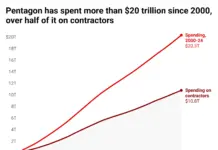America’s military-industrial complex can buy a glittering ‘patriotic’ image amongst its own public, but our image abroad will only become uglier because the world-at-large dislikes a country addicted to the perpetration of invasions and coups.

The National Priorities Project headlines “U.S. Military Spending vs. the World” and reports: “World military spending totaled more than $1.6 trillion in 2015. The U.S. accounted for 37 percent of the total.” But it can’t be believed, because, even if other nations aren’t under-reporting their military expenditures, the U.S. certainly is — under-reporting it by about 50%. The reality is approximately twice the official figure, so that America’s current annual military expenditures are around $1.5 trillion, which is to say, almost equal to that entire global estimate of “more than $1.6 trillion in 2015.”
America’s actual annual military budget and expenditures are unknown, because there has never been an audit of the ‘Defense’ Department, though an audit has routinely been promised but never delivered, and Congresses and Presidents haven’t, for example, even so much as just threatened to cut its budget every year by 10% until it is done — there has been no accountability for the Department, at all. Corruption is welcomed, at the ‘Defense’ Department.
Furthermore, many of the military expenditures are hidden. One way that this is done is by funding an unknown large proportion of U.S. military functions at other federal Departments, so as for those operations not to be officially “‘Defense’ Department” budget and expenditures, at all. This, for example, is the reason why Robert Higgs, of The Independent Institute, was able to report, on 15 March 2007, “The Trillion-Dollar Defense Budget Is Already Here”. He found that America’s military expenditures, including the ones he could identify at other federal agencies, were actually already nearly a trillion dollars ($934.9 billion) a year:
To estimate the size of the entire de facto defense budget, I gathered data for fiscal 2006, the most recently completed fiscal year, for which data on actual outlays are now available. In that year, the Department of Defense itself spent $499.4 billion. Defense-related parts of the Department of Energy budget added $16.6 billion. The Department of Homeland Security spent $69.1 billion. The Department of State and international assistance programs laid out $25.3 billion for activities arguably related to defense purposes either directly or indirectly. The Department of Veterans Affairs had outlays of $69.8 billion. The Department of the Treasury, which funds the lion’s share of military retirement costs through its support of the little-known Military Retirement Fund, added $38.5 billion. A large part of the National Aeronautics and Space Administration’s outlays ought to be regarded as defense-related, if only indirectly so. When all of these other parts of the budget are added to the budget for the Pentagon itself, they increase the fiscal 2006 total by nearly half again, to $728.2 billion.”
…
Much, if not all, of the budget for the Department of State and for international assistance programs ought to be classified as defense-related, too. In this case, the money serves to buy off potential enemies and to reward friendly governments who assist U.S. efforts to abate perceived threats. … [As regards] Department of Homeland Security, many observers probably would agree that its budget ought to be included in any complete accounting of defense costs. … The Federal Bureau of Investigation … devotes substantial resources to an anti-terrorist program. The Department of the Treasury informs us that it has ‘worked closely with the Departments of State and Justice and the intelligence community to disrupt targets related to al Qaeda, Hizballah, Jemaah Islamiyah, as well as to disrupt state sponsorship of terror.’”
But, almost everything there relied upon mere estimates, because the Congress and the President always supply to the public numbers that are sadly uninterpretable by anyone who wants to know what percentage of the federal government is actually military.
For example, on April 3rd, the White House, as required by law, sent to Congress “the Seven-Day-After report for the Consolidated Appropriations Act, 2018 (Public Law 115-141). The President signed this Act into law on March 23, 2018.” That’s the currently authorized spending for the entire U.S. Federal Government.
It was broken down into twelve categories, some of which were for multiple federal Departments, in order to make the reported numbers as uninterpretable as possible — for example, nothing was shown for the Treasury Department, but something was shown for “Financial Services and General Government Appropriations” and it didn’t even mention the “Treasury” Department. And nothing was shown for the Justice Department, nor for the Commerce Department, but something was shown for “Commerce, Justice, Science, and Related Agencies” (whatever those are). However, as bad as this is, the military (or invasions) department is even less fathomable from the publicly available reports than those other ones are. The ‘Defense’ Department is the only one that’s still “unauditable” so that in one of the attempts to audit it:
The audits of the FY 1999 DoD financial statements indicated that $7.6 trillion of accounting entries were made to compile them. This startling number is perhaps the most graphic available indicator of just how poor the existing systems are. The magnitude of the problem is further demonstrated by the fact that, of $5.8 trillion of those adjustments that we audited this year, $2.3 trillion were unsupported by reliable explanatory information and audit trails or were made to invalid general ledger accounts.”
Largely as a consequence of this, Wikipedia’s “Military budget of the United States” is a chaotic mess, though useful for links to some sources (all of which are likewise plagued as being uninterpretable).
On 1 March 2011, Chris Hellman headlined “The Real U.S. National Security Budget: The Figure No One Wants You to See”, and he estimated (using basically the same approach that Higgs had done in 2007, except less accurate than Higgs, due to failing to base his numbers on “the most recently completed fiscal year, for which data on actual outlays are now available” but instead using only the President’s budget request) that at that time, the U.S. Government was spending annually on ‘Defense’, “$1,219.2 billion. (That’s more than $1.2 trillion.)” That amount was far less than the totals that the Inspector General of the U.S. Department of Defense had been reporting, in some of its periodic investigations (such as the one just cited), to have been missed or undocumented or falsely ‘documented’ as having been spent, by that Department; but, for some mysterious reason, the American people tolerate and re-elect ‘representatives’ who ‘debate’ and rubber-stamp such corruption, which is of enormous benefit to corporations such as Lockheed Martin and Boeing, whose sales and profits depend upon the U.S. Government and its allied governments.
Any privatization of the ‘Defense’ industry, in America or any other country — treating its military operations so as to produce profits for investors (investors in mass-murder) — thus guarantees that the national-security function will be heavily loaded with lobbying and graft, because the military industry’s entire market is to one’s own government and to its allied governments: it’s not a consumer market, but a government one. Thus, privatized military suppliers grow virtually to own their government; democracy consequently becomes impossible in such nations. And, one outcome from that is the uninterpretable financial reports by America’s government, regarding ‘Defense’.
For example, probably fewer than 1% of Americans have even been informed by the press as to what the currently authorized annual federal spending for the ‘Defense’ Department is. When the Washington Post, on 23 March 2018, reported their main story about the FY 2018 federal spending authorizations (“In late-night drama, Senate passes $1.3 trillion spending bill, averting government shutdown”), the figure for the ‘Defense’ Department was buried inconspicuously in a 52-word passage within that 1,600-word ‘news’-report, which was otherwise loaded with distractive trivia.
The buried passage reads:
The legislation funds the federal government for the remainder of the 2018 budget year, through Sept. 30, directing $700 billion toward the military and $591 billion to domestic agencies. The military spending is a $66 billion increase over the 2017 level, and the nondefense spending is $52 billion more than last year.”
That’s all. For readers interested in knowing more, it linked to their 2,200-word article, “Here’s what Congress is stuffing into its $1.3 trillion spending bill”, and all that it said about the military portion of the new budget was the 27-word passage, “defense spending generally favored by Republicans is set to jump $80 billion over previously authorized spending levels, while domestic spending favored by Democrats rises by $63 billion.”
Though 23 categories of federal spending were sub-headed and summarized individually in that article, ‘Defense’ wasn’t one of them. Nothing about the budget for the U.S. Department of ‘Defense’ — which consumes more than half of the entire budget — was mentioned. However, the reality was that, as Defense News reported it, on 7 February 2018 — and these figures were unchanged in the bill that President Trump finally signed on March 23rd — “Senate leaders have reached a two-year deal that would set defense spending at $700 billion for 2018 and $716 billion for 2019.”
This year’s $700 billion Pentagon budget is 54% of the entire $1.3 trillion FY 2018 U.S. federal budget. Another article in Defense News on that same day, February 7th, noted that “‘I’d rather we didn’t have to do as much on non-defense, but this is an absolute necessity, that we’ve got these numbers,’ said the Senate Armed Services Committee’s No. 2 Republican, Sen. Jim Inhofe, of Oklahoma.” So: 54% of the federal budget wasn’t high enough a percentage to suit that Senator; he wanted yet more taken out of non-‘defense’. How can people (other than stockholders in corporations such as Raytheon) vote for such a person? Deceit has to be part of the answer.
Using similar percentages to those that were employed by Higgs and by Hellman, the current U.S. annual military expenditure is in the neighborhood of $1.5 trillion. But that’s more than the total authorized federal spending for all departments. Where can the extra funds be coming from? On 5 February 2018, CNBC bannered “The Treasury is set to borrow nearly $1 trillion this year”. Then, charts were presented on 10 May 2018 by Dr. Edward Yardeni, headlined “U.S. Government Finance: Debt”, in which is shown that the U.S. federal debt is soaring at around a trillion dollars annually; so, that extra money comes from additions to the federal debt. Future generations of U.S. taxpayers will be paying the price for the profligacy of today’s U.S. aristocracy, who receive all the benefits from this scam off the public, and especially off those future generations. But the far bigger losses are felt abroad, in countries such as Iraq, Libya, Syria, Yemen, and Ukraine, where the targets will be suffering the consequences of America’s invasions and coups.
Notwithstanding its pervasive corruption and enormous uncounted waste, the U.S. military is, by far, the U.S. institution that is respected above all others by the American people. A great deal of domestic propaganda is necessary in order to keep it that way. With so many trillions of dollars that are unaccounted for, it’s do-able. All that’s needed is a tiny percentage of the huge graft to be devoted to funding the operation’s enormous PR for ‘patriotism’. And this treasonous operation has been sustainable, and very successful (for its ultimate beneficiaries), that way, in the U.S., at least for decades.
I have previously explained why specifically military corruption has come to take over the U.S. Government, but not certain other governments. And the result of its having done so has by now become obvious to people all around the world, except in the United States itself. Furthermore, ever since the first poll was taken on that matter, in 2013, which showed that globally the U.S. was viewed as the biggest national threat to peace in the world, a subsequent poll, in 2017, which unfortunately was taken in fewer countries, showed that this negative impression of the U.S. Government, by the peoples in those fewer countries, had actually increased there during the four intervening years. So: not only is the situation in the U.S. terrible, but the trend in the U.S. appears to be in the direction of even worse.
America’s military-industrial complex can buy a glittering ‘patriotic’ image amongst its own public, but America’s image abroad will only become uglier, because the world-at-large dislikes a country that’s addicted to the perpetration of invasions and coups. Just as bullies are feared and disliked, so too are bully-nations. Even if the given bully-aristocracy becomes constantly enriched by their operation, economies throughout the world suffer such an aristocracy, as being an enormous burden; and, unfortunately, the American public will get the blame, not America’s aristocracy — which is the real beneficiary of the entire operation. This deflection of blame, onto the suckered public, precludes any effective response from the publics abroad, such as boycotts of U.S.-branded products and services might be. Instead, American tourists abroad become increasingly perceived as ‘the ugly American’. The restored ‘Cold War’ — this time with no ideological excuse (such as communism) whatsoever — could produce a much stronger global tarnishing of America’s global reputation. The beneficiaries, apparently, just don’t care.
Top Photo | President Donald Trump and Vice President Mike Pence greet military personnel during a visit to the Pentagon, July 20, 2017. (AP/Pablo Martinez Monsivais)
By Eric Zuesse
Eric Zuesse is an Investigative historian and the author, most recently, of They’re Not Even Close: The Democratic vs. Republican Economic Records, 1910-2010, and of CHRIST’S VENTRILOQUISTS: The Event that Created Christianity, he authored this piece for the Saker Blog.
Disclaimer: We at Prepare for Change (PFC) bring you information that is not offered by the mainstream news, and therefore may seem controversial. The opinions, views, statements, and/or information we present are not necessarily promoted, endorsed, espoused, or agreed to by Prepare for Change, its leadership Council, members, those who work with PFC, or those who read its content. However, they are hopefully provocative. Please use discernment! Use logical thinking, your own intuition and your own connection with Source, Spirit and Natural Laws to help you determine what is true and what is not. By sharing information and seeding dialogue, it is our goal to raise consciousness and awareness of higher truths to free us from enslavement of the matrix in this material realm.
 EN
EN FR
FR


























